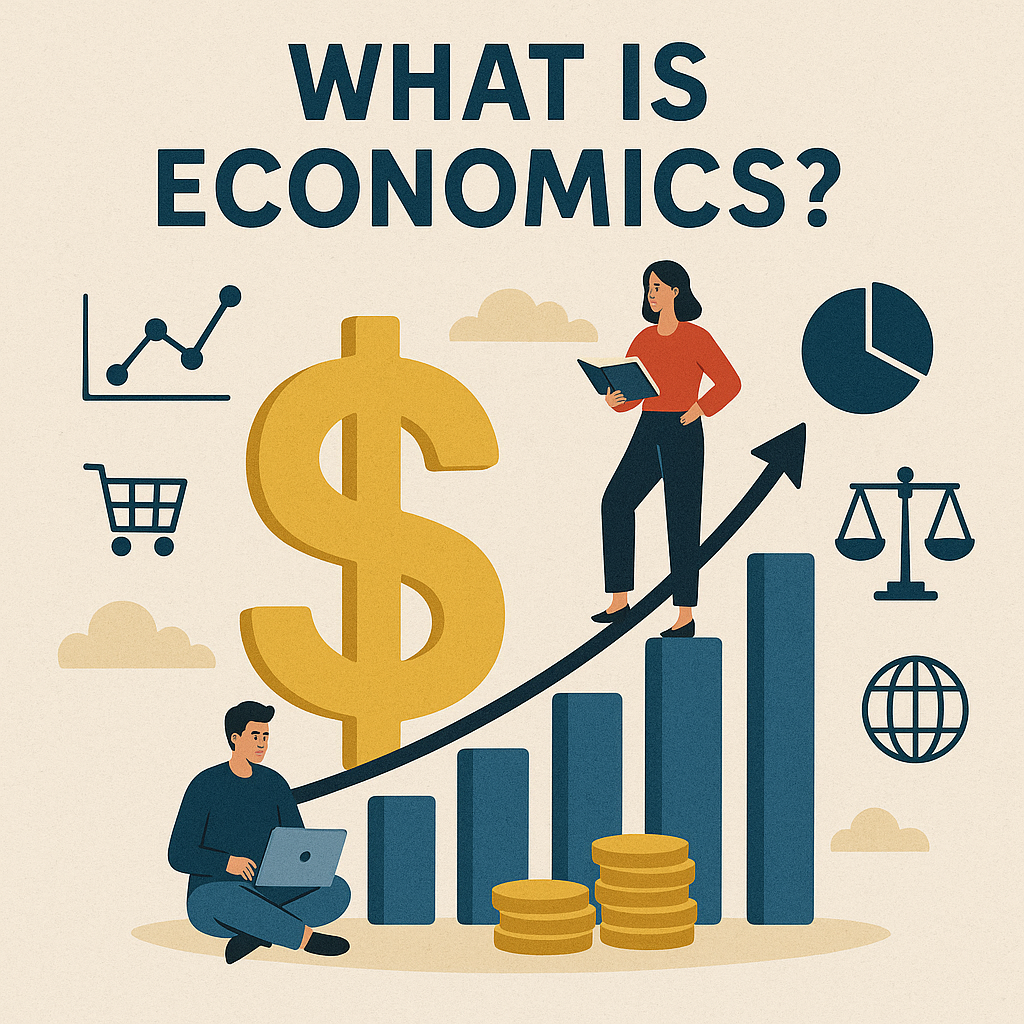Three Key Phases in Economics
1. Recession
In times of recession, there isn’t much money circulating among people, businesses lack vitality, and overall demand is low. Economic growth slows, production weakens, and financial markets like the stock market typically underperform.
2. Inflation
(Defined in detail previously.)
3. Stagflation
In stagflation, liquidity is high but production is low. Due to a decrease in consumption, unemployment rises, demand falls, and this leads to higher inflation.
Causes of Stagflation:
-
High interest rates
-
Lack of public trust (reduced investment)
Quick Comparisons:
-
Inflation = Increased production → higher prices
-
Recession = Decreased production → lower prices
-
Stagflation = Decreased production but higher prices
Market Psychology: Having the Right Perspective
Also known as market sentiment, it follows this emotional cycle:
Optimism → Excitement → Pride → Satisfaction → Anxiety → Thoughts → Fear → Despair → Panic → Capitulation → Discouragement → Depression → Hope → Relief → Optimism
Key Insight:
Ups and downs, drops, and rallies are a normal part of financial markets. Learn to be adaptable and continue educating yourself.
Types of Risks in Financial Markets
-
Systematic Risk: Market-wide risk (e.g., war, pandemic) — unavoidable
-
Unsystematic Risk: Specific to an industry or company (e.g., hacking or failed projects)
Essential Economic Concepts Everyone Should Know
-
Market Nature
-
Types of Risk
-
Behavioral Economics & Market Psychology
-
Fear & Greed Index
-
Potential vs. Actual Production
-
Potential Output: With economic stability
-
Actual Output: Based on real-time market developments
-
Major Global Banks
Banks are a cornerstone of economic systems, facilitating global transactions and policy implementation.
Examples of Major Central Banks:
-
FED (Federal Reserve, USA)
-
RBJ (Reserve Bank of Japan)
-
ECB (European Central Bank)
-
BOE (Bank of England)
-
BOC (Bank of Canada)
Key Websites for Economic Education
One of the most important resources is the Federal Reserve’s official website, where users can access:
-
Dates
-
Economic reports
-
News releases
-
Policy statements
Main Types of Economic Policies
Monetary Policy
Used to control inflation, implemented by central banks (e.g., interest rate changes, money supply).
Fiscal Policy
Used to tackle recession, implemented by governments (e.g., taxation, spending).
Key Balance:
To manage inflation and recession, we must balance supply and demand.
Two Main Schools of Economic Thought
1. Classical Economics
-
Famous economist: Adam Smith
-
Belief in free markets with minimal government intervention
2. Neoclassical Economics
-
Famous economists: John Maynard Keynes, Milton Friedman
-
Advocates government management of demand and centralized planning
Taxes in Economics
Taxes are a key component of economic policy. They involve the transfer of a portion of income or profit to the government, which provides the infrastructure for earning those incomes.
-
Lower taxes → More disposable income for people
-
Higher taxes → Less money in the hands of people
The Laffer Curve
-
Tax revenue increases with higher tax rates up to a point
-
Beyond a certain level, too high a tax rate discourages work and leads to reduced tax revenue
-
Tax rates must be optimized to balance productivity and revenue
Capitalist Countries
In capitalist economies, markets are free, not centrally planned.
People can run businesses freely, but must pay taxes.
Examples: Hong Kong, Singapore, New Zealand, Australia, USA
Communist Countries
Governments control all aspects of the economy; people have no economic freedom. Decisions are centrally planned.
Interest Rate
The cost of borrowing money or the return on investment over time. Interest rates are a major economic tool and reflect the time value of money.
Countries with strong economies typically have well-managed interest rates.
Monetary Base (High-Powered Money)
This refers to money held by the central bank, including:
-
Currency
-
Reserves
-
Gold
-
Foreign assets
-
Government debts
When this money enters the economy, it gets multiplied by a factor known as the money multiplier.
Balance Sheet
A financial statement showing the assets and liabilities of a company or government at a specific point in time.
-
Shrinking the balance sheet = contractionary policy
-
Example: Russia reduced its dependence on the U.S. dollar and increased gold reserves to control its monetary base
Government Borrowing (Overdrafts)
When a government borrows from its central bank, it leads to:
-
Money printing → larger monetary base
-
Money multiplier effect
-
Higher inflation
Causes of an Expanding Monetary Base:
-
Government debt
-
Increase in foreign reserves
-
Bank borrowing from central banks
Securities in Financial Markets
Financial instruments that represent ownership or debt with measurable value.
Types:
-
Stocks
-
Bonds
-
Participation securities
Why Are Bonds So Important?
-
Show the relationship between bond prices and interest rates
-
Reflect the central bank’s balance sheet operations
-
Help identify recession and inflation trends
-
Reveal government and bank policies
-
Allow market forecasting
Important Notes About Bonds
-
Note 1:
Bond prices and interest rates are inversely related (like a seesaw) -
Note 2:
Bond prices and yields are inversely related -
Note 3:
Bonds are safer and less risky than stocks -
Note 4:
Bond yields send strong signals about recessions and inflation -
Note 5:
Longer maturity = higher expected yield -
Note 6:
Investor sentiment is often reflected in bond demand
Types of Bonds by Duration
-
Short-Term: Under 1 year
-
Mid-Term: 1–10 years
-
Long-Term: Over 10 years
10-Year Bond Benefits:
-
Shows investor confidence in the economy
-
Considered a safe asset
-
Attracts large institutional investors
Bond Purchases and Money Supply
-
Increased bond purchases = More money in circulation → Expansionary monetary policy
-
Decreased bond purchases = Less money supply → Contractionary policy
Repo Market (Repurchase Agreement)
When one bank temporarily lends money to another using bonds as collateral, usually for short periods (e.g., 24 hours). Known as Repo Agreements.
Quantitative Easing (QE)
An unconventional monetary policy used to boost money supply when traditional methods fail.
Benefits:
-
Increases money supply
-
Expands central bank balance sheet
-
Encourages bond purchases by central banks
Tapering
A gradual reduction of QE asset purchases to:
-
Control interest rates
-
Influence investor expectations
Emergency Asset Purchases (PEPP)
Used during crises like COVID-19 to stabilize markets.
Hawkish Market
-
Also called the “Hawk Market”
-
Contractionary
-
Falling bond purchases
-
Optimism about future growth
-
Usually linked with tapering
Dovish Market
-
Also called the “Dove Market”
-
Expansionary
-
Interest rates fall
-
Lower economic optimism
-
Usually linked with QE
Example FOMC Statement Summary
-
Economic activity and employment are improving
-
Job gains are strong, unemployment has fallen
-
Inflation remains high, driven by supply-demand imbalance and energy prices
-
Russia’s invasion of Ukraine brings uncertainty and inflationary pressures
Okun’s Law
Unemployment ↓ = Production ↑, and vice versa
Phillips Curve
Wages ↑ → Inflation ↑ → Unemployment ↓



